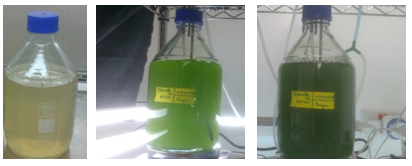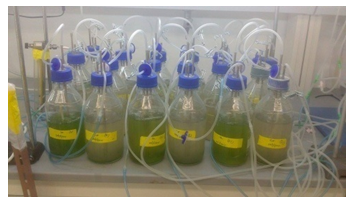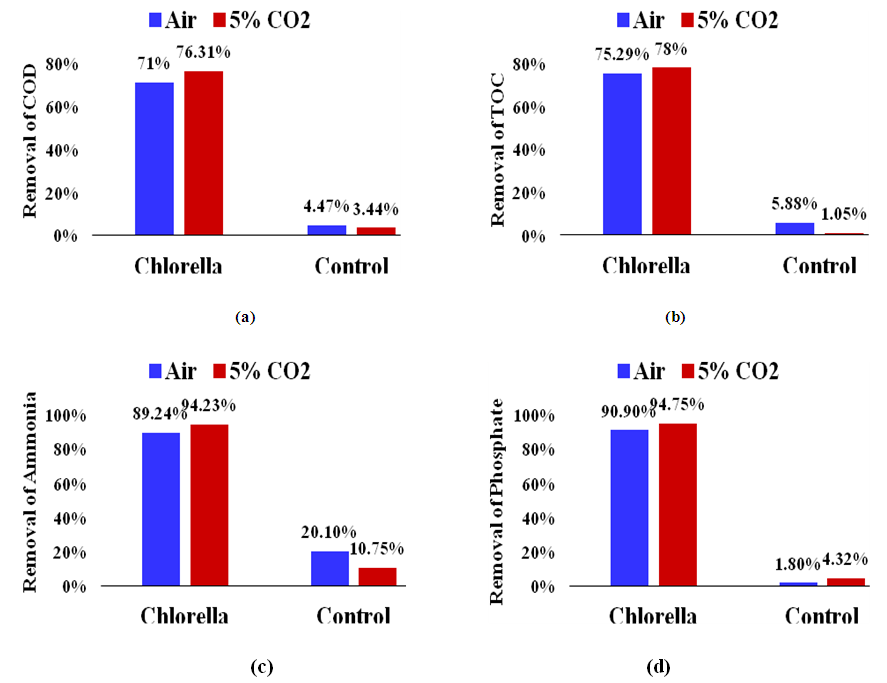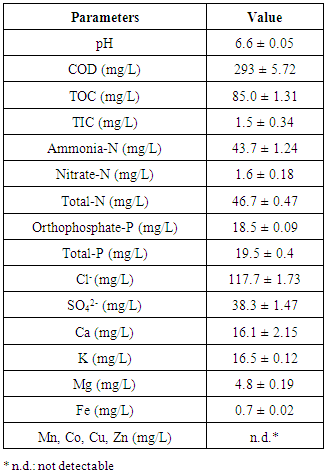-
Paper Information
- Previous Paper
- Paper Submission
-
Journal Information
- About This Journal
- Editorial Board
- Current Issue
- Archive
- Author Guidelines
- Contact Us
American Journal of Environmental Engineering
p-ISSN: 2166-4633 e-ISSN: 2166-465X
2016; 6(3): 99-103
doi:10.5923/j.ajee.20160603.03

Comparison between Normal Air and CO2-enriched Air for Municipal Wastewater Treatment by Chlorella vulgaris
Ramjee Chaudhary1, 2, Yen Wah Tong2, 3, Anil Kumar Dikshit1
1Centre for Environmental Science and Engineering, Indian Institute of Technology Bombay, Mumbai, India
2Department of Chemical and Biomolecular Engineering, National University of Singapore, Singapore
3Environmental Research Institute, National University of Singapore, Singapore
Correspondence to: Ramjee Chaudhary, Centre for Environmental Science and Engineering, Indian Institute of Technology Bombay, Mumbai, India.
| Email: |  |
Copyright © 2016 Scientific & Academic Publishing. All Rights Reserved.
This work is licensed under the Creative Commons Attribution International License (CC BY).
http://creativecommons.org/licenses/by/4.0/

Microalgae present very good option for treatment of various kinds of wastewaters with the aim to harvest the biomass for different purposes like biogas or biodiesel production, feed supplements for animals, etc. Algae utilize organic carbon present in municipal wastewater for their metabolic growth and multiplication. In addition, these also take up nutrients such as nitrogen and phosphorus from wastewater. In the present study, axenic culture of Chlorella vulgaris ATCC 13482 was used for treatment of primary municipal wastewater. All experiments were conducted in cylindrical glass bottles of 1 liter working volume in batch mode maintained at 25°C and 4000 lux light intensity with 14 hr/10 hr of light/dark cycle for a period of 10 days. Chlorella inoculum was grown in municipal wastewater with supply of normal air and air enriched with 5% CO2 (vol./vol.). The aim of this study was to compare the effects of normal air and CO2-enriched air on the efficiency of wastewater treatment by the algae. The supply of 5% CO2 gave better result than that of normal air for wastewater treatment wherein COD, ammonia-N and phosphate decreased by 76.3%, 94.2% and 94.8% respectively.
Keywords: Municipal wastewater, Chlorella vulgaris, Nutrients uptake, Treatment efficiency
Cite this paper: Ramjee Chaudhary, Yen Wah Tong, Anil Kumar Dikshit, Comparison between Normal Air and CO2-enriched Air for Municipal Wastewater Treatment by Chlorella vulgaris, American Journal of Environmental Engineering, Vol. 6 No. 3, 2016, pp. 99-103. doi: 10.5923/j.ajee.20160603.03.
Article Outline
1. Introduction
1.1. Background
- The conventional method of municipal wastewater treatment has been the aeration in activated sludge process. Hence, a major contribution to greenhouse gas emissions comes from power consumption at mechanically aerated wastewater treatment plants. Together with that, handling sludge is also a challenge for these treatment plants. During the last decade, use of algae has gained lot of importance in research because of their extensively wide applications ranging from wastewater treatment options (Carlsson et al., 2007; Chevalier et al., 2000; Garcia et al., 2006; Guzzon et al., 2008; Woertz et al., 2009), CO2 utilization (Packer, 2009; Kumar et. al, 2011) to production of protein-rich edible neutraceuticals (omega3 fatty acids) (Costa et al., 2003; Lee, 2001; Olaizola, 2003) and for green energy source e.g. biodiesel, methane and ethanol (Chisti, 2007; Milledge, 2011).
1.2. Goals and Objective
- From the view point of measures to contain environmental pollution and resource recovery, cultivation of green algae is expected to cater to various needs: (i) algal mediated uptake of organic content and nutrients from municipal wastewater and hence, its treatment earns positive water footprint for the project (ii) bioremediation of CO2 in flue gas through algal growth (production of 1 kg of algal biomass consumes nearly 2 kg of CO2) (Herzog and Golomb, 2004) (iii) use of recovered O2 for aerobic treatment of wastewater (1 kg of CO2 utilized by algae produces nearly 0.73 kg of O2 as per the stoichiometry of photosynthesis) (iv) production of biodiesel as sustainable source of eco-friendly and green fuel from lipid in algae gains carbon credits (v) use of left over algal dry mass for biogas generation under anaerobic condition. The objective of the current research work was to compare the effects of normal air and CO2-enriched air on the efficiency of municipal wastewater treatment by the algae.
2. Materials and Methods
2.1. Wastewater Sampling and Analysis
- Municipal wastewater (WW) was collected from the primary sewage tank at Water Reclamation Plant at Ulu Pandan in Singapore and stored at 4°C until further analysis. Wastewater sample was filtered through 0.45 µm filter to remove suspended particles and its characteristic parameters, given in Table 1, were estimated in triplicates (mean ±s.d.) as per Standard Methods for the Examination of Water and Wastewater (APHA, 2005). pH of wastewater sample was analyzed using Multi-Parameter Analyzer (3200M Agilent Technologies, USA). Chemical oxygen demand (COD), total-N, ammonia-N, nitrate, total-P, phosphate and sulphate were analyzed using the chemical kits and DR900 colorimeter (Hach, USA). Total inorganic carbon (TIC) and total organic carbon (TOC) were analyzed using TOC-VSH Analyzer (Shimadzu, Japan). Presence of few metals (Ca, K, Mg, Fe, Mn, Co, Cu and Zn) in wastewater sample necessary for growth of green algae was analyzed by ICP-OES (Perkin Elmer Optima 5300DV, USA).
|
2.2. Microalgae Culture
- Stock culture of Chlorella vulgaris ATCC 13482 was obtained as generous contribution from Prof. Loh Kai Chee’s lab at National University of Singapore. This microalgae species has been used for biological treatment of different kinds of wastewaters (Ji et al., 2013; Abou-Shanab et al., 2013). The algae was maintained in Bold’s Basal medium (URL1) in 3-litre conical flask at 25°C and fluorescent light of 4000 lux for 14 hr/10 hr light and dark cycle and agitated at 100 rpm on magnetic stirrer. Sterile air at flow rate 0.2 vvm was bubbled through 0.2 µm filter.
2.3. Acclimatization Study
- Chlorella grown in Bold's Basal (BB) medium for 10 days was acclimatized to municipal wastewater in cylindrical glass bottles of 2 litre working volume (inoculum to wastewater ratio as 1:20 i.e. 5% vol./vol.) before starting the treatment study. Fluorescent light of 4000 lux was supplied for 14 hr/10 hr light and dark cycle with normal air flow at 0.2 vvm. Wastewater sample was diluted with DI water in respective ratios of 30%, 60% 90% and 100% (vol./vol.) for acclimatizing algae to the wastewater. Controls with BB medium but without wastewater were also used to grow the algae. Fig.1 shows reactors for acclimatizing Chlorella to municipal wastewater.
 | Figure 1. Acclimatizing algae to municipal wastewater |
 | Figure 2. Chlorella acclimatization study |
2.4. Experimental Setup
- Experimental setup for treatment of municipal wastewater by Chlorella is shown in Fig.3. Working volume of the reactors was one-liter with sterile air supply maintained at 0.2 L/min over a period of 10 days. Filtered samples of the wastewater were autoclaved at 121°C for 15 minutes before being fed into the reactors. 950 mL municipal wastewater mixed with 50 mL algae inoculum was used in each reactor. Controls (without Chlorella) were also used to know the evaporative loss of nutrients and COD (in case if any) by air stripping.
 | Figure 3. Experimental setup for treatment of wastewater by Chlorella |
3. Results and Discussion
3.1. Supply of Normal Air
- Controls (without Chlorella vulgaris) showed lower removal efficiency than those with the algae (Fig.4). Alkaline condition (7 < pH range < 8.5) remained during the test period which has been also reported in literature to be good for growth of green algae (Olaizola et al., 2004; Suryata et al., 2010). Chlorella showed removal efficiency of 71%, 89.2% and 90.9% for COD, ammonia and phosphate respectively.
3.2. Supply of Normal Air Enriched with 5% CO2
- Use of 5% CO2-laden air enhanced process of wastewater treatment by Chlorella with COD removal efficiency of 76.3% as shown in Fig.4 (a). With supply of 5% CO2, it also proved to be a better choice for uptake of ammonia and phosphate removal efficiency of 94.2% and 94.8% respectively as shown in Fig.4 (c) and Fig.4 (d).
 | Figure 4. % Decrease of (a) COD (b) TOC (c) ammonia and (d) phosphate with normal air and air enriched with 5% CO2 |
|
|
4. Conclusions
- Microalgae have shown tremendous potentials in treating wastewater from different sources. Algae utilize nutrients available in the wastewater through metabolic assimilation and hence it is possible to remove and recover nutrients in form of algal biomass from wastewater. Growing microalgae with wastewater is one of the best options as control strategy for wastewater management along with CO2 utilization. For the present study, only 5% vol./vol. algae inoculum was used and 95% vol./vol. was primary sewage municipal wastewater. Primary sewage was efficiently treated by Chlorella vulgaris and the process was enhanced with supply of air enriched with 5% CO2. COD, TOC and nutrients load (nitrogen and phosphorus) were significantly removed from the primary sewage. Further, algal biomass can be harvested and put to anaerobic digestion for methane production or lipids from algal biomass can be channelized into biodiesel production.
Abbreviations
- ATCC: American Type Culture CollectionCOD: Chemical Oxygen DemandICP-OES: Inductively Coupled Plasma-Optical Emission SpectroscopyPTFE: PolytetrafluoroethylenePUB: Public Utility Board SingaporeTOC: Total Organic CarbonTN: Total NitrogenTP: Total Phosphorus vvm: volume of gas supply/volume of liquid/minute (aeration rate)
ACKNOWLEDGMENTS
- The partial funding for this research was provided by the National Research Foundation Singapore under its Campus for Research Excellence and Technological Enterprise (CREATE) programme. The first author would also like to thank National University of Singapore for hosting him as doctoral research exchange student under joint PhD programme with Indian Institute of Technology Bombay.
 Abstract
Abstract Reference
Reference Full-Text PDF
Full-Text PDF Full-text HTML
Full-text HTML

